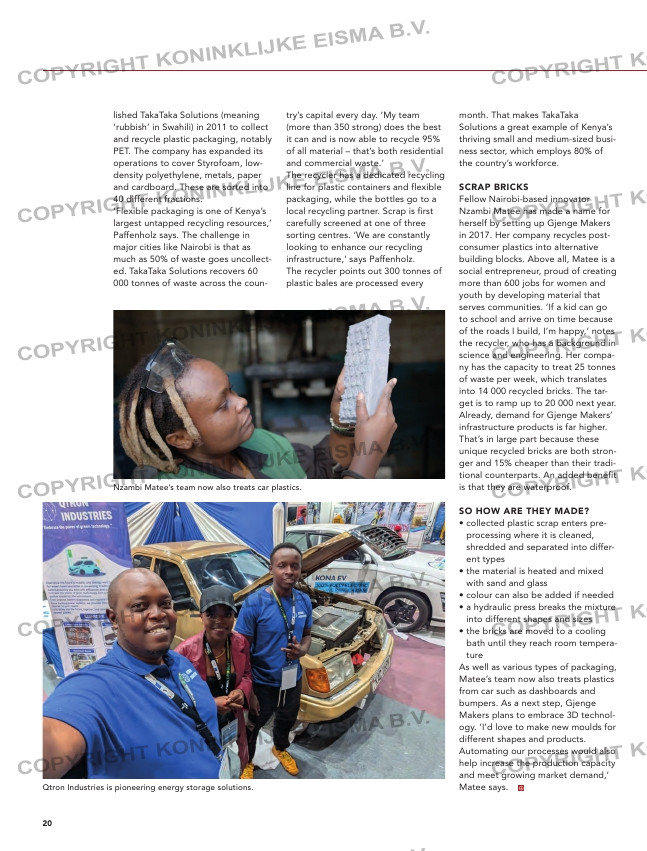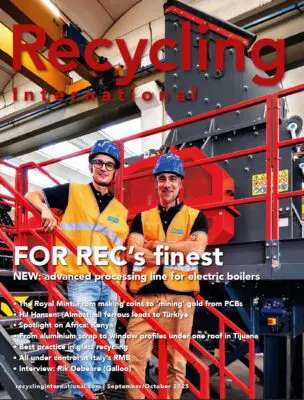Page 20 from: Recycling International September/October 2025

20
lished TakaTaka Solutions (meaning
‘rubbish’ in Swahili) in 2011 to collect
and recycle plastic packaging, notably
PET. The company has expanded its
operations to cover Styrofoam, low-
density polyethylene, metals, paper
and cardboard. These are sorted into
40 different fractions.
‘Flexible packaging is one of Kenya’s
largest untapped recycling resources,’
Paffenholz says. The challenge in
major cities like Nairobi is that as
much as 50% of waste goes uncollect-
ed. TakaTaka Solutions recovers 60
000 tonnes of waste across the coun-
try’s capital every day. ‘My team
(more than 350 strong) does the best
it can and is now able to recycle 95%
of all material – that’s both residential
and commercial waste.’
The recycler has a dedicated recycling
line for plastic containers and flexible
packaging, while the bottles go to a
local recycling partner. Scrap is first
carefully screened at one of three
sorting centres. ‘We are constantly
looking to enhance our recycling
infrastructure,’ says Paffenholz.
The recycler points out 300 tonnes of
plastic bales are processed every
month. That makes TakaTaka
Solutions a great example of Kenya’s
thriving small and medium-sized busi-
ness sector, which employs 80% of
the country’s workforce.
SCRAP BRICKS
Fellow Nairobi-based innovator
Nzambi Matee has made a name for
herself by setting up Gjenge Makers
in 2017. Her company recycles post-
consumer plastics into alternative
building blocks. Above all, Matee is a
social entrepreneur, proud of creating
more than 600 jobs for women and
youth by developing material that
serves communities. ‘If a kid can go
to school and arrive on time because
of the roads I build, I’m happy,’ notes
the recycler, who has a background in
science and engineering. Her compa-
ny has the capacity to treat 25 tonnes
of waste per week, which translates
into 14 000 recycled bricks. The tar-
get is to ramp up to 20 000 next year.
Already, demand for Gjenge Makers’
infrastructure products is far higher.
That’s in large part because these
unique recycled bricks are both stron-
ger and 15% cheaper than their tradi-
tional counterparts. An added benefit
is that they are waterproof.
SO HOW ARE THEY MADE?
• collected plastic scrap enters pre-
processing where it is cleaned,
shredded and separated into differ-
ent types
• the material is heated and mixed
with sand and glass
• colour can also be added if needed
• a hydraulic press breaks the mixture
into different shapes and sizes
• the bricks are moved to a cooling
bath until they reach room tempera-
ture
As well as various types of packaging,
Matee’s team now also treats plastics
from car such as dashboards and
bumpers. As a next step, Gjenge
Makers plans to embrace 3D technol-
ogy. ‘I’d love to make new moulds for
different shapes and products.
Automating our processes would also
help increase the production capacity
and meet growing market demand,’
Matee says.
Nzambi Matee’s team now also treats car plastics.
Qtron Industries is pioneering energy storage solutions.
UK-Kenya connection builds
battery recycling muscle
The company is partnering Nairobi’s
WEEE Centre, a leading e-waste firm
active in 18 African countries.
Through a local subsidiary, Marula
Metals Processing, Marula is injecting
EUR 500 000 into initial development.
ADVANCED PROCESSING
The new facility will recover lithium,
cobalt, manganese and nickel from
spent batteries, using proven, envi-
ronmentally sound technologies. A
line will be dedicated to extracting
black mass.
According to NEMA, Kenya gener-
ates about 51 300 tonnes of e-scrap
each year. Yet only an estimated 17%
of this waste is currently recycled,
underlining the urgent need for
advanced processing solutions.
E-MOBILITY BOOST
Momentum is building fast. Kenya’s
EV registrations surged by over 1
000% from 475 in 2022 to 5 294 by
the end of 2024. This puts further
pressure on the country’s waste man-
agement systems and heightens
demands for sustainable battery recy-
cling.
Marula Mining’s ceo Jason Brewer
says the initiative reflects the compa-
ny’s commitment to sustainable
development and Kenya’s green ener-
gy transition. ‘This project has the
potential to deliver scalable infra-
structure for critical material recycling
across the region,’ he insists.
EXCITING CHAPTER
‘Securing this partnership is a very
positive development, signalling an
16-17-19-20-21-22_africa_kenya.indd 20 09-09-2025 09:41



